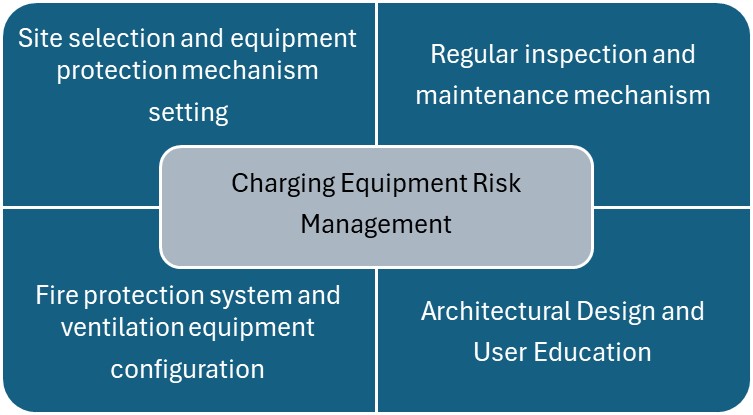With the popularization of electric vehicles and the rapid development of new energy technologies, the risks and management of electric vehicle charging equipment have become an issue that cannot be ignored in modern transportation infrastructure. At present, most new energy electric vehicles use lithium batteries as energy storage devices because lithium batteries have high energy density and stable charging and discharging performance. However, the chemical properties of lithium batteries are active and potentially dangerous. Improper operation or equipment failure may cause fires, explosions and other accidents.
Electric vehicle charging equipment is becoming increasingly popular in public and private spaces such as communities, large shopping malls, and restaurants, but high convenience also brings potential safety threats. The main sources of risk for current electric vehicle charging equipment include battery overheating, short circuits, overloads, and fire and smoke hazards when used in enclosed spaces such as underground parking lots. When many electric vehicles are charged at the same time, the risk of overload and power outage increases significantly, especially during peak hours of electricity demand. For underground parking lots, when lithium batteries catch fire, high temperatures and toxic gases such as hydrogen fluoride (HF) are generated. These gases are not only corrosive but also pose a serious threat to people's health. If the ventilation conditions of underground parking lots are limited, once a fire occurs, the accumulation of a large amount of smoke and heat will significantly increase the difficulty of rescue. Therefore, setting up appropriate and necessary ventilation and smoke exhaust devices will help reduce the occurrence of hazards. (Extended reading: Indoor lithium battery spontaneous combustion hazards, safety measures for electric vehicles spontaneous combustion)
In order to reduce the risks of electric vehicle charging equipment, effective protection mechanisms and management measures must be established. First, it is recommended that when setting up charging piles, priority should be given to the ground floor or areas near lane entrances and exits to facilitate ventilation and rescue; secondly, the charging equipment should have a comprehensive electrical protection mechanism, including leakage protection, short circuit protection, overvoltage protection, overcurrent protection and over-temperature protection, etc., to reduce the risk of fire or other accidents. In addition, regular inspection and maintenance of charging equipment is an indispensable management link. Operators and management units should formulate standard inspection specifications and maintenance procedures and make good use of data monitoring systems to understand the operating status of charging equipment. For large charging stations or underground spaces, appropriate fire protection systems and ventilation equipment must be installed and ensure that they can be activated immediately when a disaster occurs to reduce damage and hazards.
Finally, effective risk management also needs to be addressed from three aspects: building design, equipment management and user education. In terms of building design, consideration should be given to independent fire zoning, continuous sprinkler systems and smoke exhaust equipment. In terms of equipment management, equipment conditions should be checked regularly, and the management system should be optimized, such as monitoring power usage and making adjustments through the building's central control system. As for user education, safety operating regulations should be emphasized, such as avoiding overcharging, paying attention to the protection of the charging gun head, and ensuring the integrity of the cables. With the popularization of electric vehicles, risk management and safety assurance of charging equipment will become key issues for future development.

If you have any questions about safety and health related hazard prevention, response and risk management measures, please feel free to contact us.
